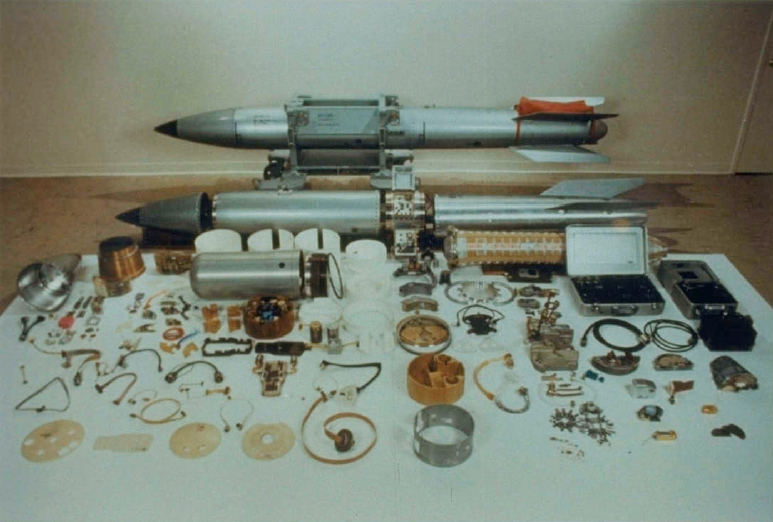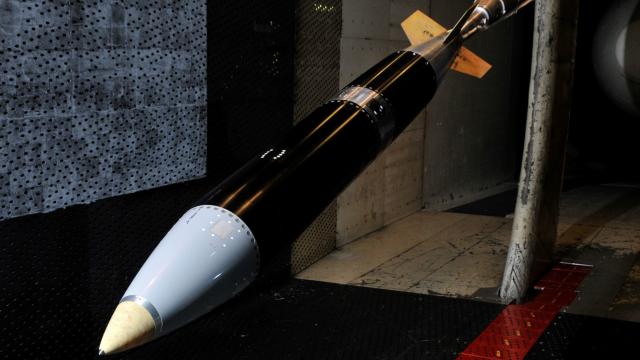The GBU-57A-B is by far America’s biggest bunker buster, but it’s not actually its most powerful one. That acclaim goes to the deep diving, hard hitting, supersonic B-61 tactical nuclear bomb. And the US is about to spend more than $US11 billion to ensure it stays on the front lines through the middle of the next decade.
Originally developed in 1960 at Los Alamos National Labs as a tactical nuclear device — that is, a bunker-busting casing wrapped around a small nuclear warhead — for penetrating heavily fortified installations and vaporizing everything inside. They were used throughout the Cold War as NATO’s front line deterrents against potential Soviet expansion, and have since become a cornerstone of the US Enduring Stockpile arsenal of nuclear weapons.

There have been a total of nine variants of the B-61, capable of delivering yields in the 0.3 to 340 kiloton range depending on settings and configurations. That’s a couple of magnitudes larger than the paltry 15 kiloton warhead we dropped on Hiroshima. The newest version, the B-61 Mk 11, has been in service since 1997. It measures just under 3.7m long and 33cm in diameter, and weighs in the neighbourhood of 317.5kg (roughly what previous iterations have). Its W80 nuclear warhead weighs another 131.5kg. However, unlike early B-61 models that relied on unstable plastic bonded explosives to implode the core, the Mk 11 employs insensitive high explosives which will not detonate if exposed to fire, shock, or impact.
With its streamlined casing, the B-61 can be mounted under the wing of a number of US aircraft — primarily the B-2 Spirit but also the F/A-18 Hornet, A-6 Intruder, F-15E Strike Eagle, basically all NATO dual role fighters. Its shape allows it to withstand extended supersonic flights and can be released at Mach 2 as low as 15.2m above the deck. The B-61 can be programmed for air burst, laydown detonation (floating to the ground using a carbon fibre parachute then exploding), and timed detonation.
It’s also far more accurate than older air dropped nuclear bombs, which reduces the necessary size of the warhead. Wherein previous tactical nukes would require a 400 kiloton equivalent head to compensate for their wide, 110-170 meter targeting radius, the B-61 will strike within just 30m (same as a JDAM) of its intended target, eliminating the need for a huge warhead to blow through that additional 100-plus metres of dirt.
Critics have voiced a number of concerns with the continued deployment of these tactical nukes. They worry that the nukes will spread radioactive fallout beyond their intended target (there’s really not much left but a smouldering crater after this thing goes boom), placing civilian lives and health in jeopardy for years to come. Plus, the political and diplomatic fallout from launching another nuke would be catastrophic for the US, what with the multiple international treaties doing so would violate.

Still, these weapons offer an unparalleled degree of deterrence, which is why the USAF is angling for $US11.6 billion to refurbish the existing stockpile of B-61 Mk11’s (estimates range from 200 to 400 units in all) into new Mk12s. These refurbished warheads would be variable yield with a user selectable detonation between 0.3, 5, 10, and 50 kilotons and could remain in service through 2025. A separate $US178 million retrofit to the Mk11’s tailfins begun in 2012 will allow the F-35 Lightning II to carry them as well as add a modest stand-off capability.
However, US Congress has stringently opposed the warhead renovations, and insists that the Pentagon look into alternatives — like maybe not using nuclear bunker busters in the heart of Europe. [Wiki 1, 2 — Ploughshares — How Stuff Works — FAS]
